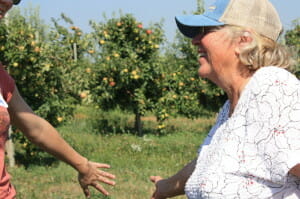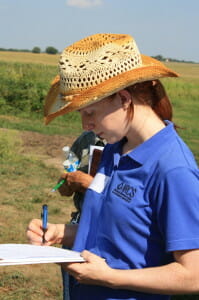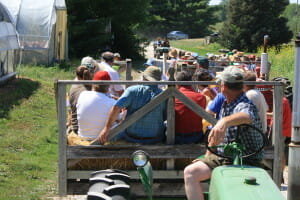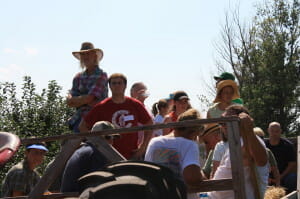Berry Patch Field Day Report
 Seventy folks endured the August 26th heat wave to visit Dean and Judy Henry’s Berry Patch Farm near Nevada and learn about fruit production and marketing.
Seventy folks endured the August 26th heat wave to visit Dean and Judy Henry’s Berry Patch Farm near Nevada and learn about fruit production and marketing.
The Henrys have been growing fruit on their Nevada farm since 70. They planted their first apple trees before they built their house – those apple trees have since been replaced.
The Berry Patch produces strawberries, apples, raspberries, blueberries, currants, gooseberries, blackberries and cherries. More information on their crops and production techniques can be found in this article from spring 2011.
Tour Tidbits
The Berry Patch sells all their products locally. Dean: “We were local before local was cool.” The farm specializes in pick-your-own, something that has caught on well in the community. They have people lined up down the driveway early in the morning for the first pick-your-own of the year.
The Berry Patch practices season extension in greenhouses and high tunnels. One of their greenhouses is heated with a wood boiler. During winter, the heater needs to be filled with wood at 5 p.m., 10 p.m., 2 a.m., and again in the morning. This often gets done on schedule, but the greenhouses has a back up propane furnace just in case.
There are four raised beds in the greenhouse. In the winter, they are planted into salad mixes and greens. Reemay (floating row cover) is placed over short hoops to create low tunnels above the crops. There is insulation underneath the raised beds; water heated by the wood boiler is piped through tubing running above the insulation to heat the soil. Temperature inside the low tunnels is kept at a minimum of 35-40, so the winter hardy greens can continue to put on slow growth and be harvested. The Berry Patch cuts 100-150 pounds of greens per week in the winter from their greenhouse.
After the greens are harvested and sold, the greenhouse is planted into tomatoes. The Berry Patch starts their seeds in January in a germination chamber, and transplants them into the raised beds in February. The heat in the greenhouse is increased for this warm season crop. They pick their first tomato harvest in the beginning of June. This tomato crop was just finishing up at the August 26 field day.
Berry Patch also raises zucchini and summer squash in their greenhouse. They sell them for $2/each in April and May. Lee Matteson, Berry Patch employee: “You can hardly give away summer squash now.”
The matted row system is the primary way the Berry Patch raises strawberries. They plant new bare-rooted dormant strawberries early spring and remove all blossoms the first season. They cover the strawberries in the winter with straw for protection. Dean said, “The trick with straw mulch is timing. I’m a weather nut because I have to be.” He subscribes to a weather service to receive accurate weather data.
New strawberry plants are kept weeded. Dean pays attention to the cost of labor with weed control and focuses more on weeds in the first half of the season versus the second. The Berry Patch maintains strawberry rows with a large cultivator and tiller. Dean: “If the plants get too thick, the berries get smaller and smaller, and more weeds and diseases persist.”

The Berry Patch keeps strawberry plantings for three to four years. Right after they tear strawberries out, they plant yellow mustard. At full bloom, they flail cop, immediately till, roll and irrigate to seal in the mustard’s allelopathic properties. The goal is to biofumigate soil-borne strawberry diseases. Dean: “It works wonderfully well. We can plant strawberries the next year.”
The Berry Patch recently replaced full sized cherries with dwarf cherries for U-pick. Varieties they are trying include Montmorency, Valentine and Jubilee.
Lee attended a conference and learned about the Rotating Cross-Arm trellis system for blackberries. This system allows trellised blackberries to be rotated down in the fall so they can be winter protected with Reemay. Fruit is getting trained to all be on the north side of the trellis for sun protection, and so harvesting and spraying can happen all on one side.
Dean sampled Honeycrisp apples when they were first released: “I had one taste and bought 500 plants.” He was told they couldn’t grow south of Minnesota but has had grown and sold a lot of Honeycrisp apples over the lat twelve years. “They are a variety that couldn’t be grown organically in Iowa,” said Dean. “They are susceptible to everything.”
The Berry Patch charges the same price for U-pick apples as the ones they sell in their farm stand. Dean: “We lose a lot of fruit to damage and sampling with U-pick. If you haven’t had an apple straight from the tree, you don’t know what you are missing. Store apples are generally picked 10-14 days before they are fully ripe so they will store better.”
Judy talked about marketing techniques. U-pick is their main market. “We enjoy it,” said Judy. “It is wonderful to see families out here enjoying the farm.” She cautioned it isn’t suitable for every farm. Judy, a former preschool teacher, has a wealth of patience and kindness, something important for a U-pick operation.
In addition to U-pick, The Berry Patch has an on-farm stand. If produce is sold beyond the farm it remains in the local market. This allows The Berry Patch to grow fruit for flavor and freshness. Since crops like berries are not shelf stable at all, the taste of local berries is quite contrasting to berries selected for shelf life and ability to endure transport. For instance, the Henry’s most popular strawberry is Honeoye. This berry gets asked for by name, but would never withstand a cross country commute to buyer’s hands.

Local markets The Berry Patch sells to include Farm to Folk, multiple farmers markets, Iowa Food Cooperative and Wheatsfield Coop. Judy has formed a lot of good relationships with customers at farmers markets, and said relationships with market managers are important as well. For instance, the Ames Farmers Market lets her close up shop when she sells out, rather than sit for a morning with nothing to sell.
If you have not had a chance to pick-your-own at the Berry Patch, it is worth a trip. Not only will you leave with delicious fruit: you will have had the pleasure of meeting a very kind family that is also very proficient at growing fruit in Iowa.


